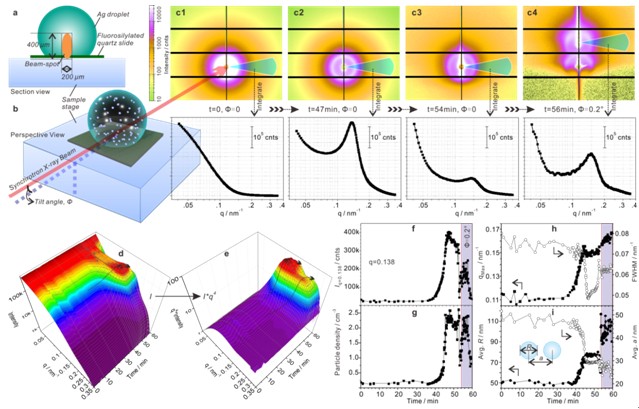A breakthrough on constructing three-dimensional (3D) surface-enhanced Raman scattering (SERS) hotspot matrix was achieved by Prof. Jinhuai Liu and Prof. Liangbao Yang from Nano-materials & Environmental Detection Laboratory. The result has been published in the Journal of the American Chemical Society (Three-Dimensional and Time-Ordered Surface-Enhanced Raman Scattering Hotspot Matrix, J. Am. Chem. Soc., 2014, 136, 5332-5341), and Dr. Honglin Liu is the first author of this article.
The ‘fixed’ or ‘flexible’ design of plasmonic hotspots is a frontier area of research in the field of surface-enhanced Ra-man scattering (SERS). Most reported SERS hotspots have been shown to exist in zero-dimensional point-like, one-dimensional linear, or two-dimensional planar geometries. Here, a novel three-dimensional (3D) hotspot matrix was demonstrated that can hold hotspots between every two adjacent particles in 3D space, simply achieved by evaporating a droplet of citrate-Ag sols on a fluorosilylated silicon wafer. In such a droplet, there is a distinct 3D geometry with minimal polydispersity of particle size and maximal uniformity of interparticle distance, significantly different from the dry state. The liquid adhesive force promotes a closely packed assembly of particles, and the interparticle distance is not fixed but can be balanced in a small range by the interplay of the van der Waals attraction and electrostatic repulsion experienced by a particle. The ‘trapping well’ for immobilizing particles in 3D space can result in a large number of hotspots in a 3D geometry. Both theoretical and experimental results demonstrate that the 3D hotspots are predictable and time-ordered in the absence of any sample manipulation. Use of the matrix not only produces giant Raman enhancement at least two orders of magnitude larger than that of dried substrates but also provides the structural basis for trapping molecules. Even a single molecule of resonant dye can generate a large SERS signal. With a portable Raman spectrometer, the detection capability is also greatly improved for various analytes with different natures, including pesticides and drugs. This 3D hotspot matrix overcomes the long-standing limitations of SERS for the ultrasensitive characterization of various substrates and analytes and promises to transform SERS into a practical analytical technique. The reviewers considered that this is a very interesting and novel concept, presents many appealing physical arguments and have many applications in the fields of plasmonics and SERS, and this paper is of high significance, high Novelty, and high broad-interest.
This work was financially supported by the National Basic Research Program of China (2011CB933700), the National Instrumentation Program of China (2011YQ0301241001 & 2011YQ0301241101), National Natural Science Foundation of China (21305142 & 21173171 & 11074210), and Anhui Natural Science Foundation (1308085QB27).
